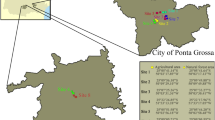Abstract
Copper, lead, manganese and zinc have been determined in extracts of industrially-contaminated soil to investigate possible sources of variability in the three-stage sequential extraction procedure recommended by BCR. Analysis was performed by flame or electrothermal atomic absorption spectrometry, using reagent matched, multi-element standard solutions. Interferences were assessed by use of a single-point standard addition. Although the distribution of contaminants in the soil was expected to be heterogeneous, little difference in precision was found when replicate samples ranging in mass from 1–5 g were extracted, provided the extractant:soil ratio was kept constant. Significant differences in operational speciation were, however, obtained when the procedure was carried out independently by three different analysts. This may be due to the critical effect of pH in Step 2. Reproducibility was higher for air-dried than for field-moist soils, but larger amount of metals were extracted, suggesting alterations in speciation occurred during drying.
Similar content being viewed by others
Author information
Authors and Affiliations
Additional information
Received: 3 August 1998 / Accepted: 26 October 1998
Rights and permissions
About this article
Cite this article
Davidson, C., Ferreira, P. & Ure, A. Some sources of variability in application of the three-stage sequential extraction procedure recommended by BCR to industrially-contaminated soil. Fresenius J Anal Chem 363, 446–451 (1999). https://doi.org/10.1007/s002160051220
Issue Date:
DOI: https://doi.org/10.1007/s002160051220




